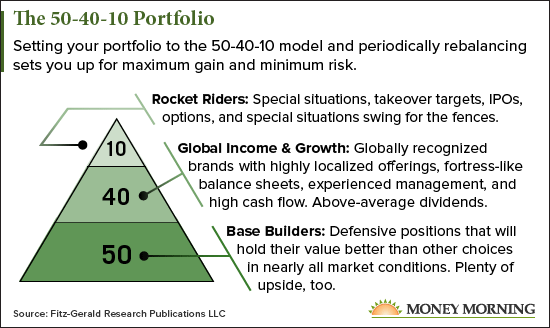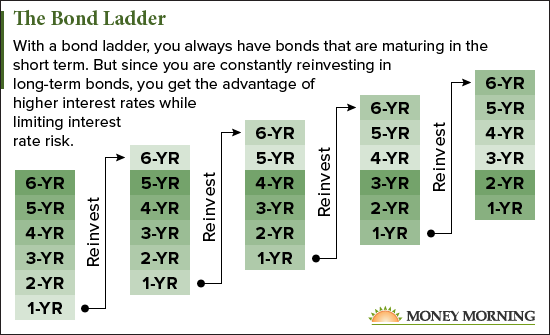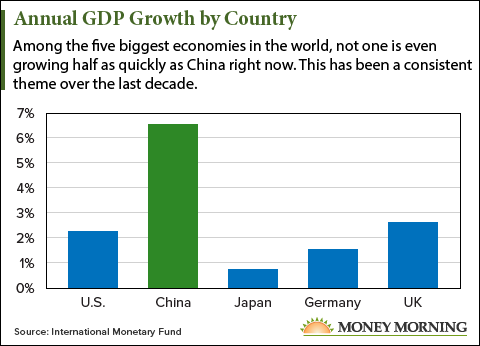We want to help you ensure that 2018 is a successful year for investing. Maybe your most profitable yet...

That means not just picking the "right" stocks, but balancing investments appropriately across your portfolio.
We'll be here to help point you to the best investments as opportunities appear throughout the year. For now, here's an excellent place to start...
Rebalancing Your Portfolio: The 50-40-10 Model
A proper asset allocation sets you up to grow your money while balancing risk.
Money Morning Chief Investment Strategist Keith Fitz-Gerald recommends the 50-40-10 model. That's 50% in foundational positions, 40% in solid growth stocks, and 10% in more speculative plays.
Using this model, Keith says you can steer yourself away from common risks and put yourself in a position for big windfall profits that pay off year after year.
All you need - besides some money to get started - is discipline.
The 50-40-10 model is not "buy and hold" and it's not "set it and forget it." Once you've got your allocations in order, you will continue to rebalance them every year. Price changes over time throw your portfolio allocation out of whack. Rebalancing puts you back on the right track.
Rebalancing also means you sometimes have to sell some of your winners. When your growth stocks have a fantastic year, for example, they might end up accounting for 50% or even more of your portfolio. If that's the case, you'll sell some of those shares and buy more bonds or speculative picks to get back to 50-40-10.

The temptation is to let the winners ride. After all, why sell your best performers? But as Keith points out, if you don't rebalance as you go, "you're simply taking on more risk."
You're not selling every share of your winning stocks - just enough to get your allocation back in line.
Does that mean you buy your "losers"? To some degree, yes.
When you know the company and its shares are healthy and in a position to succeed, any dip in price should be merely prelude to a greater rise in the near future. So selling your biggest gainers and buying the ones that haven't gained as much is actually a great way to profit year after year.
"You are effectively 'forcing' yourself to buy low and sell high," Keith says, "using proven logic - not emotion."
You might toss some big losers, especially on the speculative side. That's why Keith recommends using trailing stops to limit losses. A trailing stop sets a percentage limit - we typically recommend 25% - below a stock's highest price. If the price falls below that point, the trailing stop sells your shares.
Again, you take emotion out of the equation by setting the percentage early and sticking to it.
Now let's take a look at how to build your portfolio...
Base Builders (50% of Your Portfolio)
[mmpazkzone name="in-story" network="9794" site="307044" id="137008" type="4"]
The defensive, foundational picks will generally consist of bonds and conservative mutual funds, as well as possibly a small amount of gold.
The bonds and fixed-income investments you choose depend on a number of variables. Longer-term bonds come with a higher yield but also higher risk. As interest rates rise, bonds locked in at old rates lose value.
You also have your choice of bond types such as U.S. Treasuries, muni bonds, corporate bonds, and others.
Bonds come with two types of risk: credit risk and interest rate risk.
Credit risk is the risk that the bond issuer won't be able to pay the agreed amount. At the low end of this risk would be U.S. Treasuries, and at the high end would be junk bonds. Junk bonds are more politely referred to as "high-yield" bonds because that's how it works: higher risk means higher yield. You won't get as much return from U.S. government securities, but you are more likely to be paid in full and on time.
Interest rate risk is the risk that interest rates will rise while you're locked into a lower rate. The longer the maturity of the bond, the higher the risk. That's one reason longer-term bonds pay a higher rate, but if rates go up, they tend to go up across the board.
Interest rate risk is more of a concern if you end up selling the bond before its maturity date - in a higher-interest-rate environment, it will sell at a market rate lower than its face value. If you keep the bond to its maturity date, you'll still be paid in full even if you miss out on a slightly better rate.
As with stocks, diversity can help limit the risk of the bonds in your portfolio. A bond ladder with securities maturing at different dates helps ensure that your portfolio isn't dramatically affected by any one event.
For example, a ladder might consist of bonds that mature every year - or six months, or three months - over the next 10 years. That way, you're regularly buying new 10-year bonds at the prevailing interest rate. Over time, mild changes in interest rates aren't going to cause a major dent in your portfolio. And if you're mixing up the types of bonds, an issuer that declares bankruptcy isn't going to tank your investment performance.

You'll have to find the mix that is right for you based on your personal situation and goals. That includes not just your tolerance for risk and when you plan on needing the money, but also the tax status of your accounts. You'll probably want to put more tax-advantaged bonds such as muni bonds into taxable accounts, while taxable bonds would be better for traditional (non-Roth) 401(k) and IRA accounts.
If you'd rather not worry about managing your own bond portfolio, there are mutual funds and ETFs available that can do the work for you, and that can bolster your foundational picks with some blue-chip stocks as well. Look for funds that emphasize "capital preservation" and "fixed income."
Must See: What do billionaires Peter Lynch, President Trump, and a retired cop from Northridge have in common? They've all benefitted enormously from a curious Great Depression-era "program." And even though most have no idea this exists, it could be worth $68,870 or more to the average American. Continue reading...
A Note on Gold
A small allocation of gold in your portfolio as part of your "Base Builders" is a great addition to your investment strategy.
"Studies show that 2% to 5% allocation is about right for most investors," Keith says, "so use that as a starting point when it comes to your own portfolio."
There are three main ways to add gold to your portfolio: buy physical gold, buy a gold ETF, or buy gold miners.
Buying physical gold isn't for everyone. We have a guide here to get you started if you need it.
If you don't want to buy physical bullion from a dealer, try ETFs such as SPDR Gold Trust ETF (NYSE Arca: GLD) or Sprott Physical Gold Trust (NYSE Arca: PHYS). GLD tracks the movements of gold more closely, while PHYS shares can be traded in for the bullion itself.
Gold has been relatively stable in recent years and is showing signs of a long-term upward trend right now. In fact, our Director of Research Matthew Warder just released his latest price predictions and catalysts for gold in 2018 - see here why we're buying gold now.
Now let's move on to some stock picks...
Global Income and Growth (40% of Your Portfolio)
Your foundational picks are stable assets that will hold up well even in rough economic times, but also offer plenty of upside. Here are picks in a variety of sectors to get you started:
TECHNOLOGY: Money Morning readers know by now that the road to wealth is paved by tech. You'll almost certainly have some tech picks in your speculative plays, but some can be core assets too.
Cisco Systems Inc. (Nasdaq: CSCO) is a Silicon Valley tech giant that's been around for over three decades. Its founders were pioneers in connecting PCs via local area networks (LANs). It is already dominant in its field, but Keith recommended Cisco in October based in part on its new partnership with Alphabet Inc. (Nasdaq: GOOGL) to offer hybrid cloud services to compete with Amazon.com Inc. (Nasdaq: AMZN).
"I love to invest in companies that the markets don't understand very well or have overlooked," Keith said. Cisco provides the perfect blend of an established track record with exciting new developments that give it lots of upside. Plus it offers a yield of 2.99%.
CHINA: China has been the major growth story of the past decade. The world's second-largest economy is still growing 6.6% a year, compared to 2.3% for the first-largest (U.S.) and 1.2% for the third-largest (Japan). Top Chinese tech companies are now in the same league as the American "Fab Five," with multiple Chinese stocks achieving $400 billion market caps in 2017.
American investors simply can't afford to ignore China anymore.

One of our favorite choices in this space - which also happens to be a major tech player - is NetEase Inc. (Nasdaq: NTES).
NTES has provided Internet services in China for 20 years and has grown into one of the largest gaming companies in the world. Couple that with the country's Internet base currently growing at a pace of 40 million users per year, and you have a well-established company that's also tapped into a growth trend that will be unstoppable in the years to come.
NetEase offers a dividend yield of 0.98%.
DIVIDEND ARISTOCRATS: A select group of companies have increased their dividends every year for at least a quarter-century. They're called "dividend aristocrats," and they're a great bet for delivering returns in any economic circumstances.
Now pair that stability with the money to be made in pharmaceuticals. Sounds too good to be true, since pharma profits can depend on picking the blockbuster drugs before they become blockbusters - easier said than done.
Enter Becton, Dickinson and Co. (NYSE: BDX), which doesn't make the drugs but does make single-use syringes to deliver those drugs. Those and the many other medical products BDX makes are literally must-haves for countless people in the 50 countries where the company operates.
When the global recession brought the S&P 500 down 34.3% from June 2008 to 2009, BDX shares fell only 6.5%. Since then, the stock price is up 250% as earnings have doubled. 2017 was the 46th consecutive year the aristocrat has raised its dividend. BDX's current yield is 1.37%.
SPECIAL OPPORTUNITY: Stocks like Cisco, NetEase, and Becton, Dickinson and Co. are a great way to provide stability to your portfolio while tapping into major growth opportunities. Keith Fitz-Gerald has been researching even more aggressive income potential, too. He's found a special class of investments he calls "26(f) programs," which give investors the opportunity to tap into huge monthly income - $2,000... $5,000... or more - every month for the rest of their lives. Click here to learn how it works...
Rocket Riders (10% of Your Portfolio)
The last 10% of your portfolio is what we call the "Rocket Riders." These are the picks that come with more risk than the rest of your investments, but also come with huge upside.
These would typically be small-cap stocks that are riding major growth trends or are likely takeover targets.
Even though you're taking some risk here, there are better choices than others. And Keith Fitz-Gerald could help you turn a small stake into $815,588 in just one year with our new, fast-money research service.
The "accelerator trading strategy" is designed to take the emotion out of trading -- and to help you make money.
And it works.
Last year, we showed our readers 45 triple-digit gains. In October, accelerator trades averaged 313% gains a week, including full and partial closeouts.
Don't wait. Space is limited, and we're releasing four new moneymaking recommendations every week. Get your shot at 313% average weekly gains here...
Follow Money Morning on Twitter @moneymorning, Facebook, and LinkedIn.
About the Author
Stephen Mack has been writing about economics and finance since 2011. He contributed material for the best-selling books Aftershock and The Aftershock Investor. He lives in Baltimore, Maryland.



